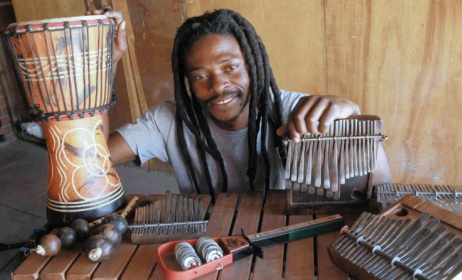‘The healing power of marimba’: How instrument is unlocking potential of special needs students
By Joan Lithgow
Music has long been recognised for its therapeutic value, offering emotional, cognitive, and physical benefits to individuals of all ages. Among the various musical instruments, the marimba has proven to be especially beneficial for learners with special needs.
 Playing the marimba, more so in a band, has profound therapeutic advantages, helping to address a wide range of developmental challenges.
Playing the marimba, more so in a band, has profound therapeutic advantages, helping to address a wide range of developmental challenges. Playing in a marimba band offers a dynamic, multi-faceted tool for the development of learners with special needs.
Playing in a marimba band offers a dynamic, multi-faceted tool for the development of learners with special needs.
In South Africa, there are few schools that are fully inclusive, catering to learners of all abilities. This is understandable as the needs of learners with disabilities vary, and all require specific environments to function effectively and successfully.
However, in any classroom environment, the marimba can be used as a learning tool regardless of learners’ abilities. In the hands of a marimba teacher who understands how to handle special needs learners, amazing results can and have been achieved.
Playing the marimba, more so in a band, has profound therapeutic advantages, helping to address a wide range of developmental challenges. Through my extensive work at Education Africa in South Africa, working with learners with special needs, I can testify to how playing in a marimba band can empower learners with a variety of special needs, fostering their growth in multiple areas of development.
Playing in a marimba band encourages learners to develop important cognitive skills, such as focus, memory, and problem-solving. It also requires learners to remember patterns, sequences, and rhythms, which can translate into improved cognitive function.
I have seen incredible results that regular attendance in a marimba band has produced in all learners, and especially learners with special needs. The stimulation of the brain’s executive functions (working memory, mental flexibility, self-control, planning, organisation, emotional regulation, problem-solving, attention, initiation, and self-monitoring) that playing in a marimba band has on learners is unprecedented.
For pupils with learning challenges or developmental delays, the marimba’s physical structure offers a visual and tactile experience that enhances learning. The process of striking the bars requires precise hand-eye coordination. This helps learners with special needs, like autism, attention-deficit/hyperactivity disorder, or dyslexia, who may struggle with abstract concepts or traditional learning methods, engage with material in a more concrete, hands-on way.
Additionally, marimba playing is often a form of emotional expression, providing learners with an outlet to express themselves in ways they may not be able to verbally. Children who experience emotional challenges, such as those with anxiety, depression, or trauma, often find playing in a marimba band a healthy way to release emotions and foster emotional regulation. The act of producing sound through the marimba can be empowering, offering a sense of accomplishment and boosting self-esteem.
I have seen remarkable physical changes in learners with physical challenges, who after a relatively short time in a marimba band, are standing for longer, playing more accurately and have far better fine and gross motor coordination. In particular, I have noticed this in learners with motor impairments, such as cerebral palsy or muscular dystrophy. Regular attendance of marimba band practices has helped develop hand strength, finger dexterity, and coordination between different parts of the body.
For learners in wheelchairs and those with limited mobility, modifications have been made to the marimbas to make playing in the band more accessible. These modifications enable learners to participate and develop skills at their own pace, enhancing confidence in their abilities and building their self-esteem.
Playing in a marimba band also enhances social skills for learners with special needs. Marimba band lessons provide opportunities for teamwork, turn-taking, and social interaction. These experiences foster a sense of community and inclusion, helping learners develop their communication and socialisation abilities in a natural and supportive environment.
For learners with autism spectrum disorder, playing in a marimba band can often serve as a bridge to improve social interaction, as it provides a non-verbal means of communication and cooperation. I have witnessed a young learner who was non-verbal and never said a word throughout his school career suddenly start talking and dancing in his wheelchair.
The collaborative nature of playing in a marimba band encourages learners to listen to one another, synchronise their playing, and respond to group cues, all of which are important social skills. Even for learners with severe communication challenges, the shared experience of making music together builds connections and friendships, promoting a sense of belonging.
The ultimate magic of playing marimbas in a band comes when learners with special needs play in ensemble with learners who are regarded as mainstream. Here we see true social cohesion in action. Every learner feels included in the ensemble regardless of where they come from.
This was evident at Education Africa’s Sounds of Celebration X concert held in September 2024 at the Linder Auditorium. Over 200 marimba players played in the concert, including 60 special needs learners. The special needs performers truly felt included. There was no way the audience could know who was a special needs performer and who was not, except for the obvious performers in wheelchairs. Inclusivity was seen in action.
Inclusive education is an approach that aims to ensure all learners, regardless of their physical, intellectual, social, emotional, or linguistic differences, have equal opportunities to learn and participate in regular educational settings. This means accommodating the diverse needs of all learners, including those with special needs, learning difficulties, and those from marginalised groups.
Nowhere is inclusivity more attainable than in the marimba band classroom, where the power of playing is witnessed.
Playing in a marimba band offers a dynamic, multi-faceted tool for the development of learners with special needs. It supports cognitive growth, emotional expression, motor skill improvement, and social integration, all of which are essential components of a learner’s overall development. Learners experience a sense of achievement and joy, breaking down barriers and unlocking their full potential.
Inclusive marimba education is about creating a culture that values diversity and promotes social inclusion, social cohesion, collaboration, and respect.
The power of marimba playing is found through:
- Using the correct technique, which involves alternating hands constantly, thus exercising both hemispheres of the brain.
- Crossing the midline which becomes automatic when using the correct technique enabling a long list of holistic educational benefits to be derived.
- Developing superior listening and focusing skills that are required for life.
- Learning by rote which radically improves the memory.
- Playing in ensemble thus enabling teamwork, empathy, sensitivity and concentration.
- Being able to play absolutely all genres of music from traditional African music to Vivaldi and everything in between is possible.
- Respecting everyone’s culture which is nurtured through the repertoire that is chosen for the marimba band to learn.
- Developing self-confidence and self-esteem in the hands of a good teacher.
- Aural training in action which can be done very successfully using marimbas.
- Developing pitch recognition with learners who are blind who within a few hours of starting to learn marimbas are able to recognise the pitch of the notes and play simple patterns and melodic lines successfully in ensemble.
- Hearing impaired learners learn to play marimbas through sign language and large movements.
The key principles of inclusive marimba education include:
- Equity: Providing all learners with the resources, support, and opportunities they need to succeed, ensuring fairness and access to learning.
- Diversity: Embracing the diverse abilities, backgrounds, and experiences of learners, and integrating these differences into the learning environment.
- Participation: Ensuring all learners actively engage in the marimba classroom.
- Supportive environments: Adapting teaching strategies, materials, and assessment methods to accommodate various learning styles and needs.
Joan Lithgow has been involved in teaching marimbas for the past 50 years and in the past 14 years has been instrumental in setting up Marimba Hubs and training teachers of blind, deaf and physically and intellectually challenged children to play the marimba in African marimba ensembles.
Joan Lithgow: MMus (Wits); BMus (Wits); HDE (PG) Wits; LTCL; LRSM
If you would like to know more about how to enable inclusive marimba education in your school programme, you can contact Joan Lithgow at joan@marimbaworkshop.co.za.






















Commentaires
s'identifier or register to post comments